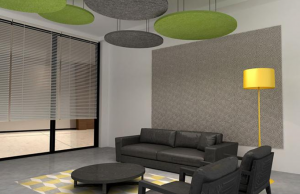Creating a peaceful environment in your home or office can be challenging, especially when noise from outside or adjacent rooms becomes disruptive. Fortunately, soundproofing your walls doesn’t have to be a complex or expensive process. There are simple, effective methods you can use to reduce noise and enjoy a quieter space. Here’s a guide to wall soundproofing with easy-to-implement strategies.

1. Seal Gaps and Cracks
One of the simplest ways to reduce noise is by sealing any gaps or cracks in your walls. Sound can easily travel through small openings, so addressing these areas can make a noticeable difference.
- Use Acoustic Caulk: Apply acoustic caulk around the edges of your walls, especially where they meet the floor and ceiling. This flexible sealant is designed to block sound and won’t crack or shrink over time.
- Seal Around Outlets and Switches: Electrical outlets and light switches are often overlooked, but they can be sources of noise leakage. Use foam gaskets or acoustic putty pads behind these covers to block sound.
2. Add Mass to Your Walls
The more mass a wall has, the better it can block sound. Adding layers to your walls can help absorb and block noise from passing through.
- Hang Heavy Curtains or Tapestries: Thick, heavy curtains or tapestries can add mass to your walls and help dampen sound. This is an easy, decorative solution that can also improve the aesthetics of your room.
- Use Soundproof Paint: While not as effective as other methods, soundproof paint can add a small amount of mass to your walls. It contains sound-absorbing fillers that can help slightly reduce noise levels.
- Install Mass-Loaded Vinyl (MLV): MLV is a dense, flexible material that can be attached to your walls to add mass and block sound. It’s particularly effective when installed behind drywall or other wall coverings.
3. Install Soundproof Panels
Acoustic panels are an excellent way to reduce noise and improve sound quality in a room. These panels are designed to absorb sound waves, reducing echoes and overall noise levels.
- Place Panels Strategically: Install acoustic panels on the walls where noise is most problematic, such as those adjacent to noisy neighbours or facing a busy street. Positioning panels at ear level or near noise sources will maximise their effectiveness.
- Choose Panels That Match Your Decor: Acoustic panels come in various colours and designs, so you can select options that complement your room’s decor while improving soundproofing.
4. Build a Bookshelf Against the Wall
A bookshelf filled with books can act as a sound barrier, adding mass and helping to block noise. This method is particularly useful for renters who can’t make permanent changes to the walls.
- Fill the Bookshelf: The more books or heavy objects you place on the shelf, the more mass you add to the wall, increasing its soundproofing capabilities.
- Cover the Entire Wall: If possible, use a bookshelf that spans the entire height and width of the wall for maximum coverage.
5. Use Soundproofing Foam or Panels
Soundproofing foam or panels are designed to absorb sound and reduce noise within a room. While they won’t block noise entirely, they can significantly reduce echoes and improve acoustics.
- Apply Directly to the Wall: Attach soundproofing foam or panels directly to the wall. These products are particularly effective in rooms where sound clarity is important, such as home theatres or recording studios.
- Combine with Other Methods: For best results, combine soundproofing foam with other methods, such as adding mass or sealing gaps.
6. Install a Second Layer of Drywall
Adding a second layer of drywall is a more involved but highly effective method for soundproofing walls. This process increases the wall’s mass, making it more difficult for sound to pass through.
- Use Green Glue Between Layers: When installing a second layer of drywall, apply Green Glue between the layers. This sound-dampening compound helps absorb sound vibrations, enhancing the effectiveness of the additional drywall.
- Consider Professional Installation: While it’s possible to install a second layer of drywall yourself, hiring a professional can ensure that it’s done correctly and effectively.
7. Hang Soundproof Curtains
Soundproof curtains are thicker and denser than regular curtains, providing additional noise reduction. These curtains are especially useful for covering windows, which can be a significant source of noise leakage.
- Install Over Walls: In addition to windows, consider hanging soundproof curtains over entire walls, particularly those that face noisy areas. This can add an extra layer of soundproofing while also providing insulation and privacy.
- Choose Curtains with Multiple Layers: Look for curtains that have multiple layers of fabric or include a soundproofing core for maximum effectiveness.
8. Rearrange Furniture
Sometimes, simply rearranging your furniture can help reduce noise. Furniture can act as a buffer, absorbing and deflecting sound before it reaches the walls.
- Place Large Furniture Against Noisy Walls: Position large pieces of furniture, such as wardrobes, sofas, or bookshelves, against the walls where noise is most problematic. This can add mass and help block sound.
- Use Rugs and Carpets: Place rugs or carpets on the floor to help absorb sound and reduce noise transmission through the walls and floors.
Conclusion
Soundproofing your walls doesn’t have to be complicated or expensive. Using simple methods like sealing gaps, adding mass, installing acoustic panels, and rearranging furniture can significantly reduce noise and create a quieter, more comfortable space. Whether you’re dealing with noisy neighbours, traffic sounds, or just want to improve the acoustics in your room, these soundproofing strategies can help you achieve your goal.
